Today on the blog, we answer a common query: why can't we use Google? Hopefully this comic provides an answer.
























The Rotation: A Himmelfarb Library Blog
Resources, tools & health news from GW Himmelfarb Health Sciences Library
Today on the blog, we answer a common query: why can't we use Google? Hopefully this comic provides an answer.
























Isn’t it great when two things which are already great on their own combine? Earlier this month, The Rotation spotlighted LibKey Nomad, a super-handy browser plugin which helps you access full text more quickly and easily. For those involved with evidence synthesis projects who use Covidence, there is some great news…

Now you can use LibKey Nomad to help you locate the full text of articles right from your Covidence screen!
Once you are logged in to Covidence, navigate to the Full text screening page, and look at your list. You will now find the LibKey Nomad icon that offers you the option to “Download PDF” – or may offer you other options of obtaining the full-text article. Here’s how it can work with Covidence:

To access the full text, click the LibKey Nomad button to download a PDF. The PDF will open in a new browser tab…

…and you can download it from there.
Next, you will click the Upload full text button, and locate the PDF wherever you downloaded it:

Once you have uploaded the PDF, this will be reflected in the display on the Full text screening page:

When you have completed this process for each study in your full text screening set, you are ready to resume your screening!
The integration of LibKey Nomad and Covidence makes what was previously a more time-consuming process quick and easy. If you aren’t using LibKey Nomad yet, install it in your browser today!

From all of us at Himmelfarb Library, we’d like to welcome all of the new residents, fellows, students, faculty, and staff who joined the GW SMHS, GWSPH, and GW Nursing community this month! We are thrilled that you’re here and we look forward to serving you during your time at GW! We know that the start of any new endeavor can be daunting, so we’d like to make it easier for you to get to know Himmelfarb Library.
To help you get the lay of the land, watch this short, video tour of the library with Himmelfarb’s Library Director, Laura Abate:
Himmelfarb Hours
Our physical space, accessible through Ross Hall, is open the following hours:
Monday - Thursday: 7:30 am - Midnight
Friday: 7:30 am - 10:00 pm
Saturday: 8:00 am - 10:00 pm
Sunday: 8:00 am - Midnight
Our current hours of operation are available on our website and include exceptions to normal hours (i.e. holiday closures). If you can’t make it to the library in person, you can get help from our librarians and staff via chat or phone (202-994-2850), or email himmelfarb@gwu.edu. Our databases, journals, and e-books are available 24/7, so even when our building is closed, you can access our electronic resources from anywhere.
Himmelfarb Resources and Collections
Himmelfarb’s collection is much larger than just the books in our stacks. We have 125 databases to search, including PubMed, Scopus, and CINAHL. The search bar towards the top of our library homepage, known as Health Information @ Himmelfarb, can be used to search for physical and electronic books, journals, articles, dissertations, and more all in just a single search box!
You can also browse and access our collection of journals from our e-journals page, or by using BrowZine. You can use BrowZine directly from your internet browser, or download the app to your IOS or Android device. BrowZine allows you to create a personalized bookshelf of journal titles, follow your favorite journals, and create alerts for new issues and tables of contents.
Here’s another pro tip: installing the LibKey Nomad browser extension on your favorite browser will provide easy access to full text when searching PubMed, Scopus, EBSCO databases, Google Scholar, Amazon, publisher sites, and more. With LibKey Nomad, you’ll be alerted when the full-text articles and e-books are available from Himmelfarb, and be able to get the PDF with a single click in most cases.
We also provide a wide range of e-books from AccessMedicine, ClinicalKey, EBSCOhost, and R2 Digital Library. You can browse our e-book collections, view our special collections in Health Information @ Himmelfarb, or search for any book via the Health Information @ Himmelfarb search tool on our homepage. We also have print books on the basement level of Himmelfarb. Most print books can be borrowed for three weeks with an additional two renewals. If we don’t have a book or article that you need, we can get it for you through our Consortium Loan Service or Documents2Go services.
Clinical Resources
Himmelfarb provides specialized apps and information services to support those of you who provide patient care. DynaMed and Lexidrug are our go-to resources for easy access to clinical care resources. If you want resources available on your smartphone or other mobile device, check out our App Shelf to download apps to selected resources. Learn more about resources available to residents on our Residents and Fellows Guide!
Research Support
Himmelfarb is more than just a physical space with lots of study space and great databases, journals, books, and e-books! Our librarians and staff can support you in your research by helping with literature searches, conducting systematic reviews, and organizing sources with RefWorks or Covidence. We can also help guide you through the constantly evolving scholarly publishing landscape through our author services.
Get help with your research from our knowledgeable reference librarians and staff. Stop by our circulation desk to get your questions answered in person, or use our Ask a Librarian service to chat with a reference librarian virtually. Our Ask a Librarian service is staffed by real Himmelfarb librarians and staff so you can be sure you’re getting the help you need! We also have a wealth of research guides that can connect you with resources on a variety of topics.
Connect with Us!
Connect with us on Instagram, Facebook, LinkedIn, and YouTube for the latest Himmelfarb news and updates! Subscribe to our blog to make sure you never miss a post!
We look forward to serving you! Welcome to the GW community!
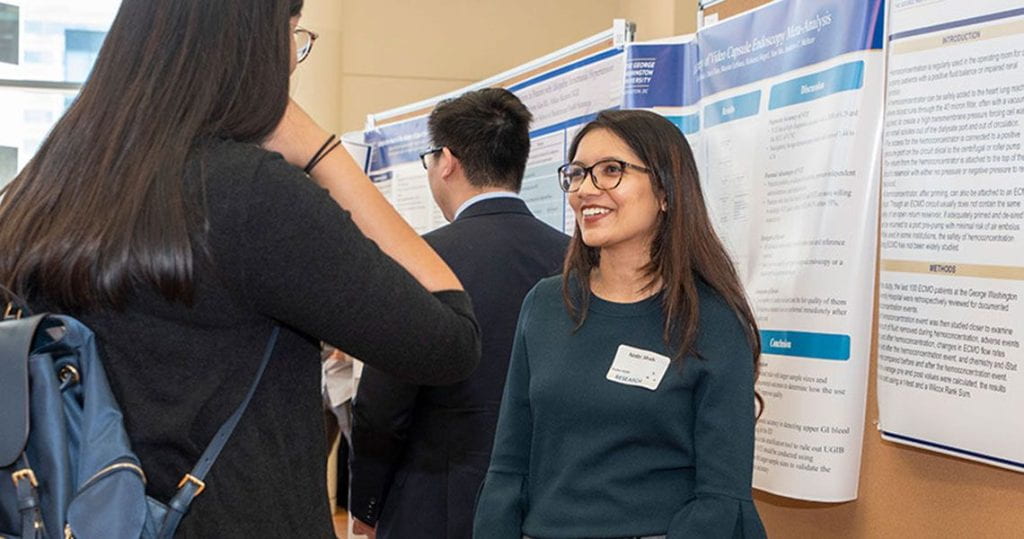
The GW Research Showcase is just around the corner! The School of Medicine and Health Sciences (SMHS) Research Showcase is at the University Student Center on April 25, 2024. This year’s Keynote Speaker, Omaida C. Velazquez, MD. will present “Gene-Modified MSCs and Direct Gene Therapy as Novel Strategies for Vascular Regeneration and Wound Healing.” The medical student poster session will be held from 1:30 pm to 3:30 pm.
While the deadline for submitting abstracts has passed, you may still be working on putting your poster together. Himmelfarb Library can help! Our GW Research Day Resources Guide has helpful resources and tips that can help make your poster stand out. The Creating Effective Posters page has poster templates, official GW logos, and the official GW Color palette to help you stay consistent with GW’s brand. If you are creating your poster using PowerPoint, the video below on Designing an Effective Poster Using PowerPoint has useful tips on size, color selection, font choices, and including graphs, charts, and photographs in your poster.
The Poster Design and Layout page also has great tips on selecting the right font, resizing images, and getting posters printed. When choosing fonts, it’s best to keep things simple and use familiar fonts like Times New Roman or Arial. Images should be 300 dpi JPEG files or full-size PDF files. If you need to resize an image, make sure that you keep the proper proportions so the image doesn’t appear distorted and “squishy” looking on your poster.
Once your poster is ready, it’s time to start thinking about how you’ll impress the judges. Here are some great videos that can help you prepare for giving your poster presentation:
The GW School of Public Health (GWSPH) Research Day was yesterday, April 9, 2024. If you participated in the GWSPH Research Day, don’t forget to submit your poster to Himmelfarb’s institutional repository, the Health Sciences Research Commons (HSRC). Archiving your poster in the HSRC is a great way to ensure that your poster is available to the global community of scholars! Archiving your work in the HSRC has several advantages:
Submitting your poster to the Health Sciences Research Commons is easy! Simply email hsrc@gwu.edu to submit your poster directly or to ask for more information.

If you’ve spent any time using Himmelfarb Library’s website, you’ve probably seen our Ask Us Chat. This chat reference service is one of the more popular ways Himmelfarb users get answers to their questions. With the rise of Artificial Intelligence (AI), it’s natural to wonder if you’re actually speaking to a real person or just a chatbot when you interact with chat services online.
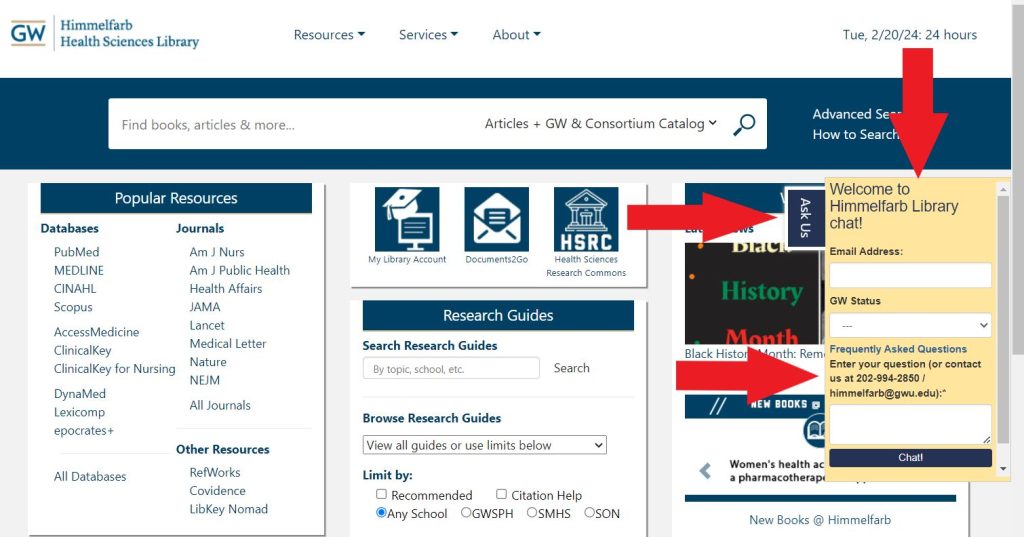
Himmelfarb’s Ask Us Chat service is staffed by real people Monday through Thursday from 8am to 8pm, and on Friday from 8am to 5pm. You’re not only chatting with a real person, but you’re chatting with a member of Himmelfarb’s dedicated reference department who are trained and skilled at finding answers to your toughest reference questions! You’ve probably even seen the person you’re chatting with around the library, or leading a webinar or tutorial you’ve watched. They might even be embedded in one of your classes!
We thought it was time that we introduce ourselves, so you can get to know some of the folks on the other side of the chat who are answering your questions. Without further ado, we’d like you to meet three of our amazing Reference Librarians: Rachel, Tom, and Deborah!
Rachel Brill
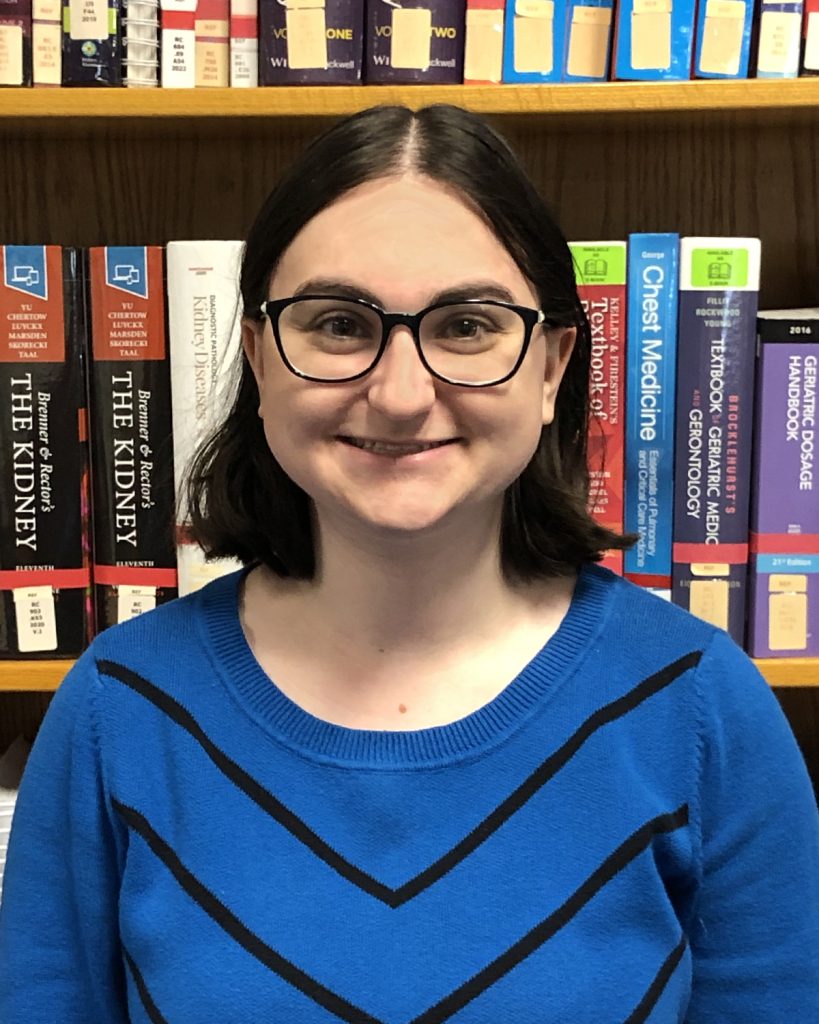
Rachel joined Himmelfarb’s reference and instruction department about two years ago, and has been a vital part of the Himmelfarb team ever since! When asked what her favorite part of working reference at Himmelfarb was, she said “It’s a really special feeling when someone’s been struggling to find that piece of information they need, and I’m able to locate it for them.” When Rachel isn’t at work, she likes to play with her cat and listen to show tunes.
Rachel wants our library users to know that “there are no ‘stupid’ questions that you can ask us - the Himmelfarb librarians are passionate about helping you learn, so ask away!”
Tom Harrod
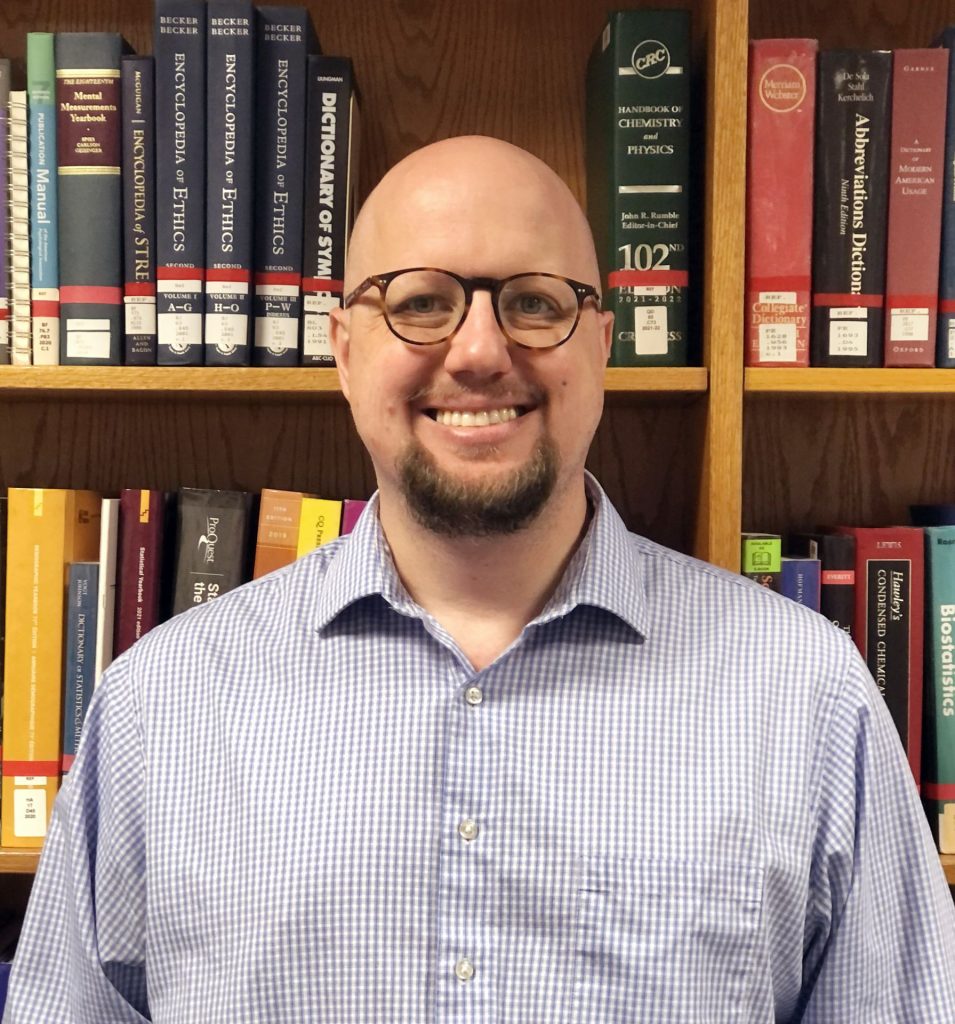
Tom has been with Himmelfarb for about 13 and a half years and is one of the longest-serving reference librarians on staff. He now oversees the Reference and Instruction and Circulation departments at Himmelfarb as Associate Director of Reference, Instruction, and Access.
Tom’s favorite part of working reference is: “the feeling of knowing you’ve helped someone do something that had previously been a source of anxiety or uncertainty for them.” Tom gave the example of being able to help a student who wants to do a systematic review but doesn’t know what that entails. He enjoys “being able to talk them through the process, breaking it down into discrete steps they can take, and eventually, they have a growing feeling of comfort with the project because they now have a direction to go.”
Tom explained that there’s such a variety of chat questions - some quick questions that can be answered in 30 seconds or less, and other, more complex questions that can go on for multiple hours! Tom shared that “after having answered many chat questions over the years, there’s always something new you’ve never heard before that presents a challenge.”
When asked about his hobbies outside of work, Tom said “I used to have hobbies but instead, I now have a 1-year-old and a 3-year-old child. I am currently able to make some time for reading and last summer I embraced the typical ‘dad’ activity of becoming enthusiastic about BBQing/smoking food on the grill.”
Tom wants our users to know that “though we do our best to answer every question that comes in via chat, we’re also happy to set up a phone, in-person, or virtual meeting to handle more complicated, in-depth consultations.” Reach out to us via email (himmelfarb@gwu.edu) to schedule a meeting!
Deborah Wassertzug

Deborah has been a valued member of our reference team since December 2022. Her favorite part of working reference at Himmelfarb is all of the people she comes into contact with, whether online or in person.
When asked about a memorable chat interaction, she had two to share:
“When I worked at another university, someone signed onto library chat and demanded to know whether I was a human being or a bot. I assured them I was human."
“At GW, my favorite chat interactions turn into consultations! Sometimes there is a quick answer, but other times it is the tip of an iceberg -- it is always fun to get to delve more in-depth with a research project someone is just starting on.”
Outside of work, Deborah enjoys going to a lot of concerts, mostly classical and indie rock. She also writes poetry. Deborah wants our users to know that “Everyone who works at Himmelfarb is truly dedicated to providing the best possible library service and the strongest support for researchers.”
Ask Us! Real People are Waiting to Answer Your Questions!
So now you’ve met some of the real people who answer your Ask Us chat questions every day! Please reach out via chat, email (himmelfarb@gwu.edu), or call us at 202-994-2850 with your questions. Regardless of your preferred method of communication, you’ll be connected to a real person who can answer your questions. And rest assured, we’ll always work to find answers to your toughest questions.
Overcoming the inertia to write a research project can be more difficult than actually writing it.
The blank document only grows more intimidating if you don’t remember previous research, or if you know that after writing, you’ll still need to find and compile all of your sources from note apps, half-references in drafts, and scraps of memory.
Fortunately, tools like RefWorks help smooth the path during both research and writing.
With RefWorks, you can aggregate and save references from our major databases like PubMed, CINAHL, and Scopus; collaborate with the Google Docs add-on; and create bibliographies (in APA 7th, AMA, etc), importing them with the Microsoft word plug-in.
Himmelfarb staff have created a great one-stop RefWorks guide.
However, if that’s overwhelming, check out this video tutorial on importing citations from PubMed or CINAHL into Refworks and start using RefWorks today!
If you have any questions, reach out to our Reference and Instructional staff at himmelfarb@gwu.edu, or 202-994-2850.

Image from Wikipedia Commons.
As we embark on a new year, it is a fantastic time to focus on an often underestimated facet of our well-being: thyroid health. January marks Thyroid Awareness Month, providing an opportunity for students, teachers, and researchers within the field of medicine to understand the importance of a well-functioning thyroid. Beyond its role in supporting our metabolism, the thyroid holds a profound connection to cognitive function and the overall energy levels we feel throughout the day which gives us all the more reason to take a moment to further understand the thyroid, and why promoting thyroid health matters.
Thyroid imbalances can manifest in symptoms such as fatigue, restlessness, difficulty concentrating, and mood swings which may hinder our ability to function during daily activities or study. If you are experiencing unexplained symptoms, it may be beneficial to seek medical advice and also to encourage your patients to as well. Early detection and management of thyroid disorders can not only alleviate symptoms but can also contribute to an improvement in the quality of life.
This January, Thyroid Awareness Month serves as a timely reminder for universities to actively promote a culture of health and well-being. Encouraging a proactive approach towards health fosters a community that prioritizes both physical and mental wellness.
In many ways, the silent hero in our well-being is the thyroid. If we take the time to understand the profound impact it has on our ability to function cognitively and advocate for regular screenings, we can collectively create a culture that empowers minds and supports the pursuit of knowledge. This thyroid awareness month, let's not only spread awareness but also take concrete steps towards a healthier, more resilient academic community.
Further reading on Thyroid health at Himmelfarb can be found at:
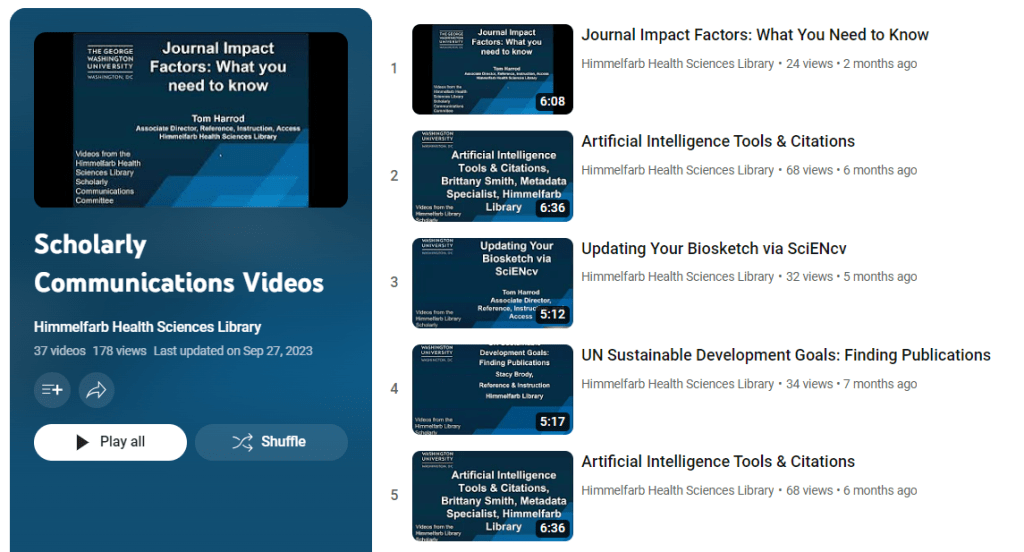
Are you interested in scholarly publishing, but aren’t sure where to start? Himmelfarb Library has a library of short video tutorials focused on a variety of scholarly publishing topics! We add new videos to this library each semester, so the library is always growing. Videos range from 3 to 10 minutes in length, so you can learn in small chunks of time that fit your schedule. Here are some of our newest videos!
Journal Impact Factors: What You Need to Know
In this video, Tom Harrod, Himmelfarb’s Associate Director of Reference, Instruction, and Access discusses journal impact factors. You’ve probably heard that journals with higher Impact Factors are more reputable, and are more desirable when the time comes to publish your research. But what is a journal Impact Factor exactly? And how is an Impact Factor calculated? This six-minute video answers both of these questions and also explores how to address Impact Factors in context and why some journals don’t have an Impact Factor.
Artificial Intelligence Tools & Citations
In this 6-minute video, Himmelfarb’s Metadata Specialist, Brittany Smith, explores generative artificial intelligence tools. This video starts off by discussing the emergence of AI and the importance of checking current guidelines and rules regarding AI, as this is a new and constantly evolving field. This video discusses how AI can help with your research, discusses GW’s AI policy, and how to create citations for AI in your research.
Updating Your Biosketch via SciENcv
Tom Harrod discusses the differences between NIH’s ScieENcv and Biosketch and demonstrates how to use SciENcv to populate a Biosketch profile in this 5-minute video.
UN Sustainable Development Goals: Finding Publications
In this 5-minute video, Stacy Brody explores why the United Nations' sustainable development goals were developed, and the intended achievements of these goals. This video discusses how to find publications related to these goals using Scopus.
Dimensions Analytics: An Introduction
Sara Hoover, Himmelfarb’s Metadata and Scholarly Publishing Librarian provides a brief overview of the Dimensions database and discusses how to access Dimensions from Himmelfarb. This 7-minute video also provides several examples of use cases for this great resource!
In addition to these great videos, you can find the full 37-video library on the Scholarly Communications YouTube Playlist and on the Scholarly Publishing Research Guide. Additional videos cover a wide range of topics including:
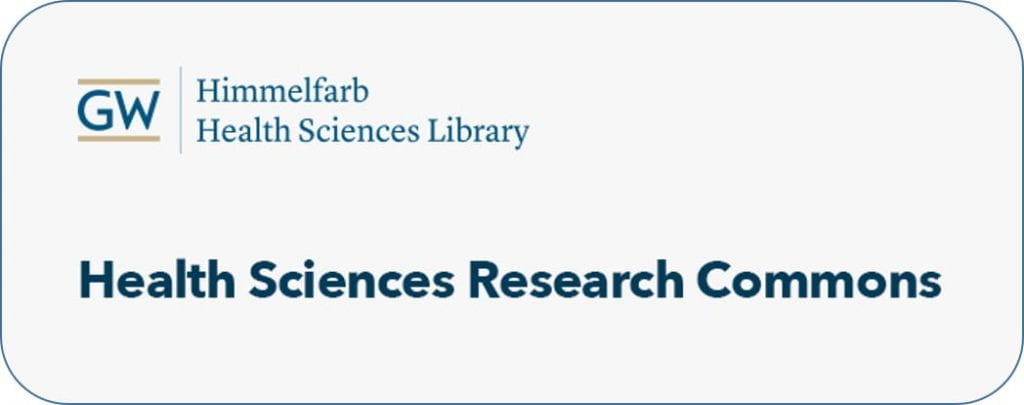
Did you recently present at a conference or during a workshop? Would you like to share your conference poster with other scholars? Are you interested in archiving your research in a central location? The Health Sciences Research Commons (HSRC) is Himmelfarb Library’s online institutional repository and allows researchers to store their research in a reliable location so it may be accessed by other researchers.
Here are a few benefits to storing your research in the HSRC:
Archiving your poster in the HSRC is a reliable alternative to conference websites which may not be maintained once the conference ends. The HSRC is able to accept most file formats and you may upload a full image of your poster. Library staff members maintain the repository and will archive your research for you. Send an email hsrc@gwu.edu and a Himmelfarb Library staff member will respond to collect more information.
Are you interested in a preview of how your poster will appear in the institutional repository? Visit the 2023 Research Days Posters collection or any of the other collections in the repository.

Fall means more than pumpkin spice. Fall grant application season is also here with October submission deadlines for both NIH and NSF. Both organizations have modified the grant application process and here’s what you need to know:
Need additional resources to help you with the grant application process?
For additional information reach out to Sara Hoover, Metadata and Scholarly Communications Librarian at shoover@gwu.edu or Himmelfarb at himmelfarb@gwu.edu.